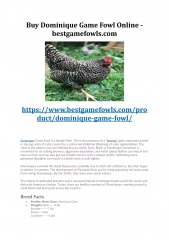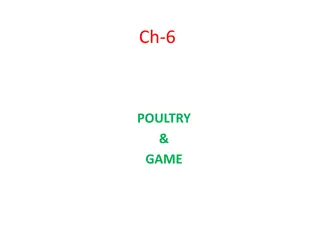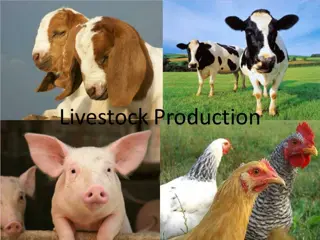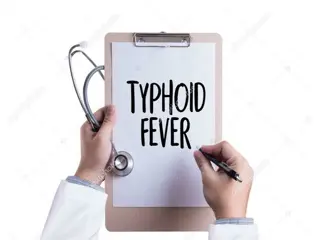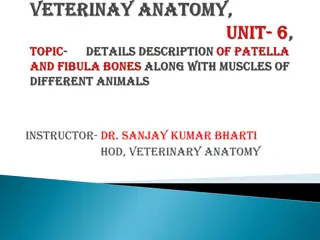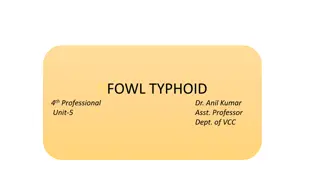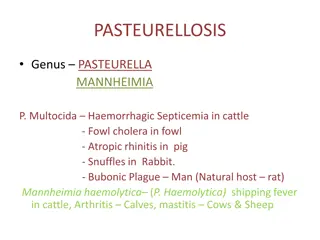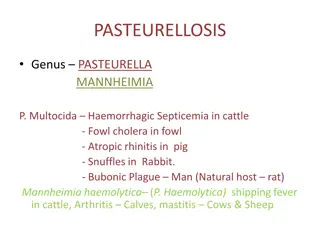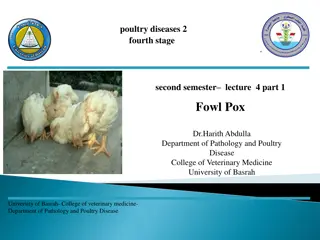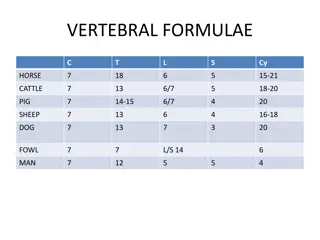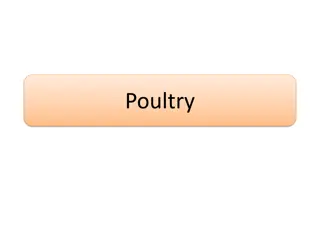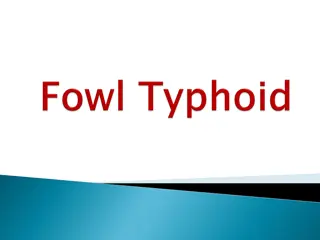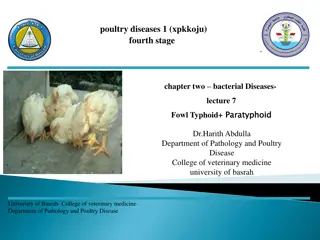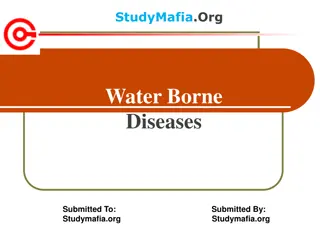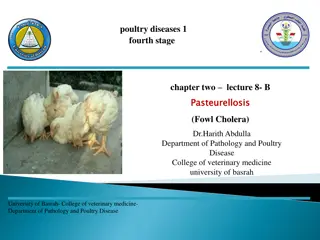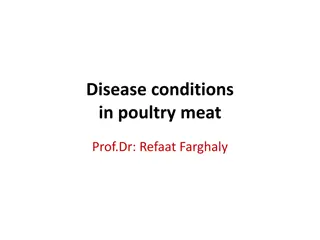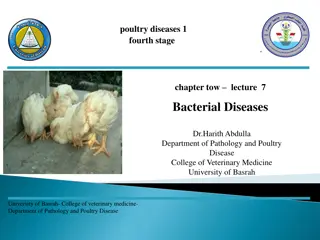Buy Dominique Game Fowl - bestgamefowls.com
Dominique Game Fowl is a female Dom. This is the presence of a \u201cbarring\u201d gene. expresses barred or zig-zag spots of color caused by a. patterned inhibition (blocking) of color pigmentation. The color in the pattern may be inhibited to pure white. Dom, Bulik, or Dominique Gamefowl, is renow
2 views • 2 slides
Overview of Poultry Diseases and their Causes
Poultry diseases caused by viruses and bacteria are a significant concern for poultry farmers. Viral diseases like Ranikhet Disease, Fowl Pox, and Avian Leucosis can have high mortality rates and severe symptoms. Bacterial diseases such as Tick Fever, Tuberculosis, Fowl Cholera, and Infectious Coryz
2 views • 12 slides
Understanding Poultry and Game: Types, Cooking Tips, and Nutritional Benefits
Poultry, including chicken, turkey, duck, goose, and guinea fowl, offers a leaner option compared to other meats, making it a healthy choice for various dishes. Game meat, sourced from animals hunted for food, provides a unique flavor profile and nutritional benefits. This article delves into the ty
0 views • 16 slides
Overview of Poultry Production: Eggs, Meat, and Systems
Poultry production encompasses the raising of domesticated fowl such as chickens, turkeys, ducks, and geese for meat and eggs. This includes caged and cage-free egg production systems, as well as meat production practices for broilers and other poultry. The industry faces scrutiny from animal rights
1 views • 21 slides
Understanding Enteric Fever (Typhoid Fever): Causes, Contagiousness, and Prognosis
Enteric fever, commonly known as typhoid fever, is an acute illness caused by Salmonella typhi bacteria transmitted through contaminated food or water. This fever is highly contagious, with individuals becoming carriers even after recovering. Close contact, contaminated water, and poor sanitation co
0 views • 18 slides
Comparative Anatomy of Sesamoid Bones in Various Animals
This content provides a detailed comparison of sesamoid bones in different animals such as ox, sheep, goat, horse, pig, dog, and fowl. It highlights the variations in size, shape, and structure, showcasing how these bones differ in anatomy across species.
2 views • 12 slides
Understanding Fowl Typhoid: Causes, Transmission, Clinical Signs, and Control Measures
Fowl typhoid, caused by Salmonella gallinarum, affects adult chickens with high mortality rates. It spreads through infected droppings, carcasses, and fomites. Clinical signs include listlessness, diarrhea, and organ swelling. Diagnosis involves isolation and identification, while treatment options
0 views • 4 slides
Overview of Pasteurellosis in Livestock
Pasteurellosis, caused by Pasteurella and Mannheimia species, affects various animals from cattle to fowl. It presents as hemorrhagic septicemia in cattle, fowl cholera in fowl, atropic rhinitis in pigs, and more. The disease is characterized by small, non-hemolytic colonies and specific biochemical
0 views • 30 slides
Understanding Fowl Cholera in Birds: Causes, Symptoms, and Management
Fowl cholera, a septicaemic disease affecting birds, is caused by Pasteurella multocida. It can affect all species of birds, with older birds more susceptible. The disease can spread through carrier birds, excretions, carcasses, and even rats. The virulence factors, clinical signs, and forms of the
2 views • 9 slides
Understanding Pasteurellosis: A Bacterial Disease in Livestock
Pasteurellosis, caused by organisms like Pasteurella and Mannheimia, affects various animals including cattle, fowl, pigs, and rabbits. The disease presents as haemorrhagic septicaemia in cattle, with symptoms like high fever and respiratory distress. It is an important bacterial disease in livestoc
0 views • 30 slides
Understanding Water Hygiene and its Health Implications
Proper water hygiene is crucial in preventing the spread of water-borne diseases like cholera, typhoid, and hepatitis. Regular testing and treatment methods such as boiling or chlorination help ensure safe water for healthcare settings. Insufficient water quality can lead to various illnesses, empha
0 views • 32 slides
Understanding Fowl Pox in Avian Species: Causes, Symptoms, and Diagnosis
Fowl Pox, caused by Avipoxvirus, is a contagious disease in birds characterized by wart-like nodules and diphtheritic membranes in the throat and mouth. It has multiple forms, including dry pox, wet pox, and coryza-like form, with varying clinical signs. The disease spreads through mosquitoes, bitin
1 views • 10 slides
Direct and Indirect Characterization in Literature
The concept of direct and indirect characterization in literature is explored through examples from popular books such as "Artemis Fowl: The Eternity Code" and "The True Confessions of Charlotte Doyle." Direct characterization involves explicit statements about a character's personality, while indir
0 views • 8 slides
Comparative Anatomy of Mammals: Vertebral and Skeletal Structures
Explore the variations in vertebral formulae, rib pairs, rib shaft characteristics, scapula morphology, humerus features, ulna differences, and metacarpals/digits among horse, cattle, pig, sheep, dog, and fowl. Detailed images and descriptions offer insights into the distinct skeletal structures of
0 views • 9 slides
All About Poultry: Nutrition, Quality, and Preparation
Explore the world of poultry, from the definition and nutritional value to the specific categories and cuts available. Learn about the quality indicators, storage tips, and hygiene practices for fresh and frozen fowl. Discover the various types of poultry, their weights, ages, and culinary uses. Enh
0 views • 20 slides
Understanding Fowl Typhoid in Domestic Birds
Fowl Typhoid is a septicemic disease affecting domestic birds, characterized by acute and chronic phases, enlarged spleen, bronzy colored liver, and diarrhea. It is caused by Salmonella gallinarum and primarily affects young and adult chickens. The disease has a short incubation period of 4-5 days,
0 views • 7 slides
Understanding Fowl Typhoid and Paratyphoid in Poultry
Fowl typhoid is a septicemic disease affecting domestic birds, characterized by acute and chronic phases, enlarged spleen, bronzy-colored liver, and diarrhea. It is caused by Salmonella gallinarum and is very lethal, with mortality reaching 75% in untreated flocks. The disease shares similarities wi
0 views • 15 slides
Understanding Waterborne Diseases: Causes, Precautions, and Types
Waterborne diseases pose a significant threat due to poor water quality caused by pollutants like industrial waste and sewage. Contaminated water can lead to various illnesses such as cholera, typhoid fever, and skin diseases. It is crucial to take precautions like filtering water, maintaining water
0 views • 20 slides
Understanding Pasteurellosis (Fowl Cholera) in Poultry: Causes, Symptoms, and Management
Pasteurellosis, also known as Fowl Cholera, is an acute septicemic disease affecting domestic fowl and wild birds caused by Pasteurella multocida. This disease is characterized by high morbidity and mortality rates, primarily impacting chickens, turkeys, and ducks. The disease spreads through health
0 views • 10 slides
Comprehensive Guide to Raising Poultry and Fowl for Beginners
Explore the complete process of raising poultry and fowl, from researching and planning to hatching eggs, brooding, housing, feeding, and understanding the differences between raising birds for meat and eggs. Learn about various bird species, their growth rates, and egg-laying capabilities. Gain val
0 views • 20 slides
Disease Conditions in Poultry Meat: Causes, Symptoms, and Lesions
This detailed information by Prof. Dr. Refaat Farghaly discusses various disease conditions in poultry meat, including bacterial, viral, parasitic, and protozoal diseases. It covers diseases such as tuberculosis, fowl cholera, marek's disease, salmonellosis, and coccidiosis, providing insights into
0 views • 28 slides
Understanding Avian Salmonellosis in Poultry: Causes, Symptoms, and Prevention
Avian Salmonellosis, a bacterial disease in poultry, is categorized into distinct forms such as Pullorum Disease, Fowl Typhoid, and Paratyphoid Infection. It is characterized by high mortality rates, affecting both young chicks and mature fowls. The disease spreads through infected eggs, leading to
0 views • 11 slides
